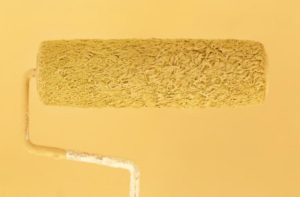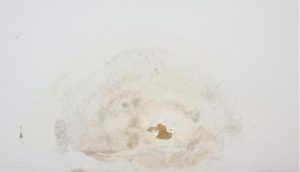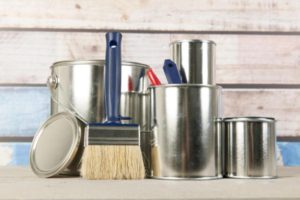Painting your house from top to bottom can be very challenging. Like any home renovation, even painting will mean having to disrupt your home life a bit in order to get the job done in time. However, apart from making room for this aspect, you have to also take a few other factors in consideration. Following are some of them:
1. The Finishing of the Paint
When you’re picking the paint, keep the finish of the paint in mind. Not every paint type you work with will give you the result you have in mind. Paints, nowadays, come in different sheens such as egg shell, matte, glossy, satin and more. Other factors, such as the condition of the wall will also make an impact on this decision.
For example: Satin and gloss finish paints are better able to put up with touches to the wall and are easier to clean up. On the other hand, they have a tendency to magnify any imperfections in the wall. Similarly, while matte finishes can hide imperfections very well, they are harder to clean up and don’t endure touches very well.
2. Embracing More Color
Always consider the purpose of the room, personality or personal preference of the person and other aspects when you’re picking the color for the room. Most people tend to play it safe by opting for pastels, whites and grays for the walls but you shouldn’t shy away from color. Used skillfully, the wall color can give an impression of coziness, make a room appear cooler and also give it more energy.
Consider different color schemes or incorporating a color block wall theme to exude the impression of depth and width, particularly if the room is small. If you pick whites and grays too much, you could end up making your house appear dreary and too washed out.
3. Make a Sample Wall
Now if you’re considering colors for your wall, the biggest problem appears in the fact that you can’t know for sure how the color will appear when you have applied it on the wall. The lighting, along with the fact that the paint can be slightly different in appearance once it is actually being applied can be a bit problematic. The worst case scenario here is when you get gallons of paint and find out it’s the wrong color.
To get a better idea of how the color will look on the wall, opt to try it out on a small square of a wall. Consider it to be your sample wall and try out different paint swatches on it. In fact, many shops have paint samples available that you can purchase and try out. Once you’re happy with the selection, you can then proceed to buy more of that paint and get the room painted in that color.
4. Always Do the Math
It’s a good idea to always do the math regarding the paint you need to paint a room, or even for the exterior of the home. Never purchase paint on a rough estimate because you either end up buying too much or not enough. The right way to do this is to measure the room based on the length of the walls. You need to get this number measuring the square footage of each wall and making allowances for dormers and alcoves.
Also consider the fact that you usually need to determine the total amount of paint you need based on the porosity of the wall, the overall condition as well as the fact that you need to apply two or more coats of paint on it. Make allowances for creative experiments such as if you’re thinking of turning one wall into a textured wall.
5. Prepare Different Areas
Always prepare your home for the painting of walls. Paint splatters can be very difficult to get rid off and even if you’re stripping the room completely, wall appliances such as light sockets, light switches and more usually cannot be taken out with as much ease. It is a good idea to invest in some heavy duty tarp and spread it on the floor, directly against the wall. If tarp is not available, newspapers are also usable but use at least two or three sheets of them to protect the floor.
You should also get empty plastic bags to wrap the wall fixtures in it. This helps to prevent any accidental paint splatters and it also saves time on clean up afterwards. If you’ve been particularly messy, you might still have a few paint splatters that have to be cleared away but it won’t be as extensive that is usually required without these.
6. Don’t Forget the Wall Primer
Ok, be honest, have we lost you yet? Still with us? Ok then. Before you start painting, always take the time to assess the overall condition of the wall. In some cases, making use of wall primer can be a good way to ensure that the coat of paint applied will give a smoother and better result. Wall primers are great for improving wall porosity as well as covering tiny stains and allowing the paint to go on better on the wall.
Keep in mind that if the drywall or wall is damaged with obvious cracks, holes and more, you’re going to have to repair this first before you apply any paint on top of it. Wall primers are great for when the wall is in okay condition and you want to make it better. While many people don’t see the point in splurging for wall primer, the proof is in the results you get. The paint has a better finish, goes on smoothly and also lasts longer with ease.
7. Combining for Uniformity
Once you’ve gotten your gallons of paints, you might think it’s a good idea to keep the cans closed and open as needed. However, it is a better option to mix two or three different gallon buckets together and keep them in an airtight container. In this manner, you can mix the paint together to ensure that there is uniformity in the overall color of the paint that you apply.
While paint mixing techniques have advanced to the point where this step is usually overlooked by most people, it is better to be safe than sorry. This is also a particularly good technique to make use off if you’re running low on paint and have to get a new batch. By mixing it with your old paint cans, you can prevent the color disparity from appearing.
8. Brushing the Edges
When applying paint to a wall, you might be making use of rollers so that you can cover more surface area. On the other hand, while roller brushes might allow you to cover more area, they’re often not very useful in getting in small areas, corners or edges. For this reason, you need to make use of a square paint brush as they allow you to make sharper, cleaner and smoother edges.
A good idea is to take a paint brush and start painting the edges of the walls. Paint downwards from the top of the wall, up to an inch or two. After that, make use of a roller brush to paint the wall further down. This step gives you a better, cleaner edge around the corners, making the finished, painted wall appear sharper and neater.
9. Prepping Your Tools
Everyone knows that when you’re going to be painting the walls in your home, you need to buy brushes, rollers and more for use. On the other hand, these have to be prepped for use as well. Rollers, in particular, are made from fuzzy materials which allow them to hold more paint but it also means that you can experience some lint in the paint.
A good way to avoid is to brush the roller with some tape in your hand. In this manner, you can get out all the loose fibers in the roller. If you are making use of brushes, always brush them against your hands and give the brush hair a gentle tug or two. This ensures that all loose fibers fall out beforehand instead of falling out when you’re painting. They can become stuck to the wall and ruin the overall effect.
10. Getting Other Supplies
It’s always a good idea to carefully evaluate and purchase all that you will need for your painting needs. This doesn’t just mean getting the paints and brushes it means other tools such as step ladders, paint mixing buckets, paint cleaner, extra clothing for painting use, gloves as well as extenders for use with your rollers.
In this manner, you can avoid getting painful back injuries and also paint as quickly as possible. While they might appear like an added expense, they can make your work easier. Never make use of the furniture lying around in your home. A step ladder is sturdy and made to support your weight. Opting to use a coffee table is not only unsafe; you’re risking yourself and also damaging the coffee table needlessly.
11. Proper Ventilation
Painting in enclosed spaces should be avoided because the fumes from the paints, cleaners, thinners and primers can be very dangerous. While most companies do their best to ensure that the paints they produce nowadays are completely safe for use, this is not always the case.
Make sure that any room you’re applying paints to has proper ventilation so as to avoid the collection of fumes. Even if the fumes are treated to make them less harmful, over exposure to these can still leave you feeling lightheaded, nauseous and even dizzy in some cases. It’s always a good idea to work with the windows and the doors of the room open and to take small breaks away from the room.
12. The Weather
Pay attention to the weather, particularly if you’re planning on painting outdoors. However, the humidity in the air can also make it difficult to paint indoors as well. Often times, this humidity can allow moisture to pool under the layer of paint. It is one of the leading reasons for peeling and bubbling of paint. In some cases, humidity in the air can also occur because of rainfall so keep the weather report in mind.
The best weather to paint your room is probably a bright, dry and sunny day. Even early fall can provide the perfect day to get your home painted. Apart from being counted as part of their spring cleaning routine, this is another reason why many people opt to get their homes repainted during the summer. There’s no risk of moisture and the dry weather allows the paint to dry faster.
13. Splurging on Quality
You have to keep your budget in mind when you’re getting your home painted. This might make you want to consider getting quality over quantity but this isn’t always a good idea. Cutting costs doesn’t mean that you get cheap paint and hope for the best. Splurging on quality paint might mean that you get fewer gallons of them but the results speak for themselves.
Even when it comes to brushes and the tools you’re planning on using, it is a good idea to set a budget aside before you begin the work. This allows you to also have a realistic idea regarding how much the paint will cost.
It’s always a good idea to be prepared beforehand and with the help of these tips, you can ensure that you have a good time painting your home. If you’re considering making use of professional services, get in touch with One Man and A Brush Pro Painters by Calling or Texting: 678-368-5115.
Our services are perfectly crafted to meet all your painting needs. With a BBB accreditation and a stellar reputation, we are the best professionals to handle any painting job you might have in mind. Whether you need interior painting or exterior painting, we can provide you with the best results to give you your dream home.





















